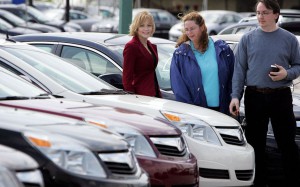This year was supposed to be the start of the slide. Higher interest rates, higher prices and lower incentives were expected to collude, forcing new vehicle buyers to the sidelines in 2018, experts predicted.
At least one expert or group of experts in this case, Edmunds, came out today to predict that it is expecting potentially record-setting sales this month and for 2018 new vehicle sales to tally 17.3 million units, eclipsing last year’s result of 17.2 million cars, trucks, minivans and utility vehicles.
“We’ve been saying all year that 2018 would be a down note for the auto industry, but it ended up defying the odds,” said Jeremy Acevedo, Edmunds’ manager of industry analysis. “Automakers are really pulling out all the stops in December to close the year on a high note, and car shoppers seem to be in a buying mood.”
Edmunds analysts forecast that 1,607,724 new cars and trucks will be sold in the U.S. in December for an estimated seasonally adjusted annual rate (SAAR) of 17.4 million, reflecting a 16% increase from November 2018 and a 0.3% increase from December 2017. Edmunds experts note that December is expected to be the second-best auto sales month of the year.
(NADA predicts new car sales will be down in 2019. Click Here for the story.)
This prediction comes just as the Federal Reserve upped interest rates again by a quarter point, making just about anything that requires a loan to become just a little more expensive. The move was not unexpected though some experts felt the economy is beginning to soften.
“The Committee judges that some further gradual increases in the target range for the federal funds rate will be consistent with sustained expansion of economic activity, strong labor market conditions, and inflation near the Committee’s symmetric 2 percent objective over the medium term,” the Fed statement said.
President Donald Trump spent much of the morning banging the drum to against hiking rates, and was surprisingly quiets in the hours after the announcement was made.
(Click Here to see why its not just the U.S. market facing a downturn, China is too.)
Despite the rate hike, one area that helped the industry come back strong in 2018 were fleet deliveries, and this has Edmunds analysts concerned. The group estimates that retail SAAR will come in at 14.6 million vehicles in December 2018, with fleet transactions accounting for 16.1% of total sales. An estimated 2.7 million used vehicles will be sold in December 2018, for a SAAR of 39.7 million (compared to 3.0 million — or a SAAR of 39.8 million — in November).
“Even though 2018 is ending stronger than expected, there are a lot of reasons to approach 2019 with caution,” Acevedo said. “Automakers continue to rely heavily on upping fleet sales to mask eroding retail demand, and that’s not a sustainable place to be. “A record number of lessees returning to the market should help give dealers a boost in the New Year, but rising interest rates and vehicle costs are going to continue to give car shoppers pause and create uncertainty in the market.”
Despite the fact that this year was expected to come in below 17 million units according to the predictions of just about everyone in the auto industry. The unexpected year didn’t affect the bravery of some executives.
(To see how FCA saved the November sales numbers, Click Here.)
Toyota Motor North America’s Bob Carter recently told reporters that he was going “repeat my mistake from last year” and predicted that sales in North America would come in between the mid-16 million and high-16 million range. Others, including the National Auto Dealers Association, Edmunds and IHS Automotive, have also settled on that range for 2019.


